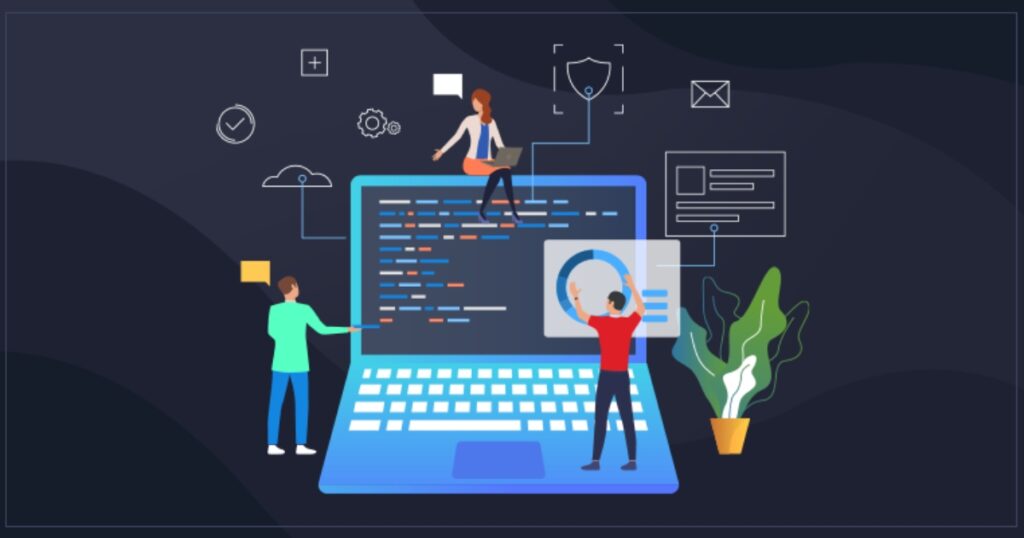Custom web application development has become an essential part of many businesses’ digital strategies. With a custom-built web app, companies can streamline processes, improve efficiency, and provide better service to their customers. However, developing a high-quality web application requires careful planning, expertise, and the right development approach.
In this article, we’ll explore five tips to help boost your productivity when undertaking a custom web application development project. Following these suggestions can help ensure your web app meets business requirements, delivers value, and gets built without delays or cost overruns. Let’s dive in!
The 5 Custom Web Application Development Tips are:

Clearly Define Business Requirements Upfront
Defining clear business requirements at the start of a custom web development project is one of the most important things you can do to boost productivity. Before your developers write a single line of code, all stakeholders should understand the goals and intent behind the web app.
Here are some key questions to get answered upfront:
- What challenges is the web app trying to solve?
- Who will use the web app?
- What key functions and features are needed?
- How will the web app integrate with existing systems?
- What are the budget constraints?
- What is the timeline for completion?
Documenting detailed functional specifications, user personas, integration points, and UI/UX requirements will maximize productivity. It ensures developers understand what they are building for whom. It also reduces miscommunications that can delay projects and result in functionality that misses the mark.
Spending time aligning on requirements at the start pays dividends later in development speed and higher quality output.
Choose the Right Technology Stack
The technology stack powering a custom web app significantly impacts productivity throughout the development process. The right stack allows developers to efficiently build applications that are scalable, secure, and maintainable.
Some key considerations when selecting a web development stack include:
Front-end Technologies: HTML, CSS, JavaScript frameworks like React, Angular, or Vue. Consider developer experience, component libraries, and ability to create dynamic and reactive UIs.
Back-end Technologies: Languages like Node.js, Python, Ruby, PHP, and Java. Evaluate factors like scalability, community support, and built-in libraries.
Database Technology: SQL vs NoSQL databases, managed cloud databases, caching layers. Consider data models, transactions, and flexibility needs.
Infrastructure: Cloud platforms like AWS, GCP, Azure. Evaluate ease of deployment, built-in services, and manageability.
Development Tools: Frameworks, libraries, IDEs, collaboration tools. Choose tools that maximize developer productivity.
Take time upfront to carefully evaluate technology options and choose solutions that best fit the needs of the web app and the capabilities of the development team. The right stack provides the foundation for an efficient development process.
Architect for Scale and Performance
A key best practice when building custom web applications is to architect the system for scale and performance from the very beginning. It’s much more difficult to bolt on scalability after an app is already complete.
Some tips for architecting scale:
Plan for concurrency – Use queues, caches, and asynchronous processing for bottlenecks.
Distribute workload – Partition databases, use CDNs, and avoid single points of failure.
Make stateless – Design components to minimize retained state where possible.
Cache aggressively – Cache reusable data, requests, and computations to optimize repeated access.
Manage sessions wisely – Store session data in a databass or cache instead of in-memory.
Use cloud services – Cloud platforms provide auto-scaling capabilities.
For performance:
Benchmark and load test – Continuously measure and improve slow areas of code.
Optimize databases – Index tables, tune queries, and optimize data models.
Lazy load when possible – Only load data when it’s needed to speed initial load.
Compress responses – Use gzip and minification to reduce payload sizes.
Use a CDN – Distribute static assets globally.
Limit external calls – Reduce latency by limiting external API requests.
By keeping scalability and performance central in architecture decisions, teams can build web apps that sustain growth and deliver speedy user experiences.
Automate Testing and Deployments
Automating testing and deployment pipelines is key for maintaining productivity as a web app evolves. Manual processes quickly become time-consuming bottlenecks.
For testing:
Automated unit tests – Use a framework like Jest or Mocha to test modules in isolation.
Automated integration tests – Validate how components interact with each other.
Functional/UI tests – Use Selenium or Cypress to simulate user flows.
Load/performance testing – Stress test the app under production loads.
CI/CD integration – Run test suites on every code commit.
Automated tests free developers from performing repetitive manual tests. They provide quick feedback on changes and prevent regressions.
For deployments:
Containerization – Containerize apps using Docker for standardized deployments.
Infrastructure as code – Define infrastructure in a config to enable repeated deployment.
One-click deploys – Provide easy deployment options to promote releases.
Zero-downtime deploys – Use blue-green or rolling deploy patterns.
Rollback options – Roll back on failure to restore previous working state.
Monitoring – Monitor app health, logs, and metrics. Get alerts on issues.
With automated deployments developers can ship updates frequently and reliably. Automation frees them from time-consuming manual deployment processes.
Foster Effective Team Collaboration

Smooth collaboration between team members is essential for web app development productivity. Development involves many interdependencies between contributors. Roadblocks can easily arise if collaboration breaks down.
Some tips for effective collaboration:
Frequent communication – Overcommunicate details, plans, and blockers.
Task management – Use boards to track progress and visualize workflows.
Code collaboration – Use version control and code reviews to share code.
UX collaboration – Collaboratively review designs and prototypes.
Cross-functional teams – Avoid siloed roles to promote end-to-end ownership.
Shared goals – Ensure everyone understands business objectives and how they contribute.
Quick feedback – Provide early and frequent feedback loops.
Automated alerts – Get notified when things go wrong through monitoring.
Knowledge sharing – Encourage documentation, wikis, and informal learning.
By promoting transparent and frequent collaboration, teams gain collective ownership over the web app and can nip issues in the bud before they derail productivity.
Ensuring a strong foundation in website design and development is paramount, as it significantly contributes to maintaining a seamless development process while mitigating unproductive delays. Dedicate ample time to meticulous planning, make informed technology choices, prioritize scalability in your design, automate various processes, and foster transparency among team members.
By adopting these essential practices, custom web app development can evolve into an efficient and productive endeavor that ultimately yields substantial business value. These guidelines underscore critical factors for organizations embarking on these intricate yet promising projects.
FAQs
Custom web application development is the process of building a web-based software application specifically designed to meet unique business requirements. Unlike off-the-shelf software, custom web apps are developed from scratch for a particular use case.
Benefits include full optimization for required workflows and user needs, flexibility to handle changing needs, integration with existing systems, competitive differentiation, and ability to retain full ownership and control.
Custom development is best when off-the-shelf solutions don’t fully address business needs. The investment is justified for core apps central to operations or strategic initiatives requiring specialized capabilities.
Crucial planning elements include defining business requirements and user needs, detailing technical specifications, scoping features, evaluating technology choices, budgeting, building a timeline, and assembling a skilled development team.
Common technologies include JavaScript frameworks like React for front-end, Node.js/PHP/Python for back-end, MySQL/MongoDB for databases, and cloud platforms like AWS for deployment and infrastructure.
Focus on vertical scaling, distribute workload across servers, use caching, enable asynchronous processing, optimize databases, and leverage cloud auto-scaling capabilities.
Typical maintenance includes monitoring performance, fixing bugs, adding features, improving UX, keeping frameworks up-to-date, managing infrastructure, backing up data, and ensuring security and compliance.
Related Articles
 Anas is our go-to copywriter with a knack for crafting persuasive and high-converting eCommerce landing pages. His passion for words and understanding of consumer psychology helps turn visitors into loyal customers. When he's not refining his copy, Anas enjoys exploring the latest digital marketing trends and experimenting with new writing techniques. His blend of creativity and strategic thinking makes him an indispensable part of our energetic team.
Anas is our go-to copywriter with a knack for crafting persuasive and high-converting eCommerce landing pages. His passion for words and understanding of consumer psychology helps turn visitors into loyal customers. When he's not refining his copy, Anas enjoys exploring the latest digital marketing trends and experimenting with new writing techniques. His blend of creativity and strategic thinking makes him an indispensable part of our energetic team.












